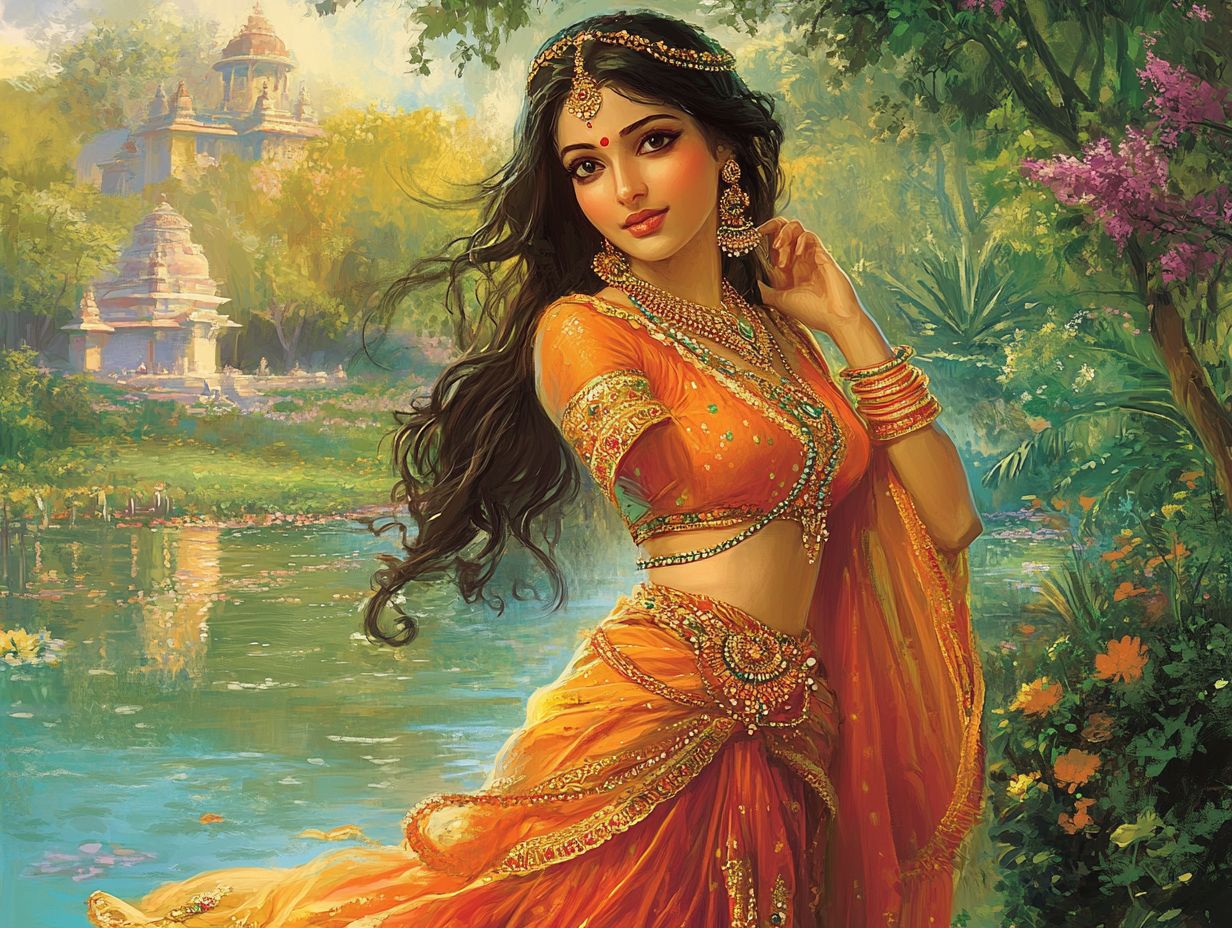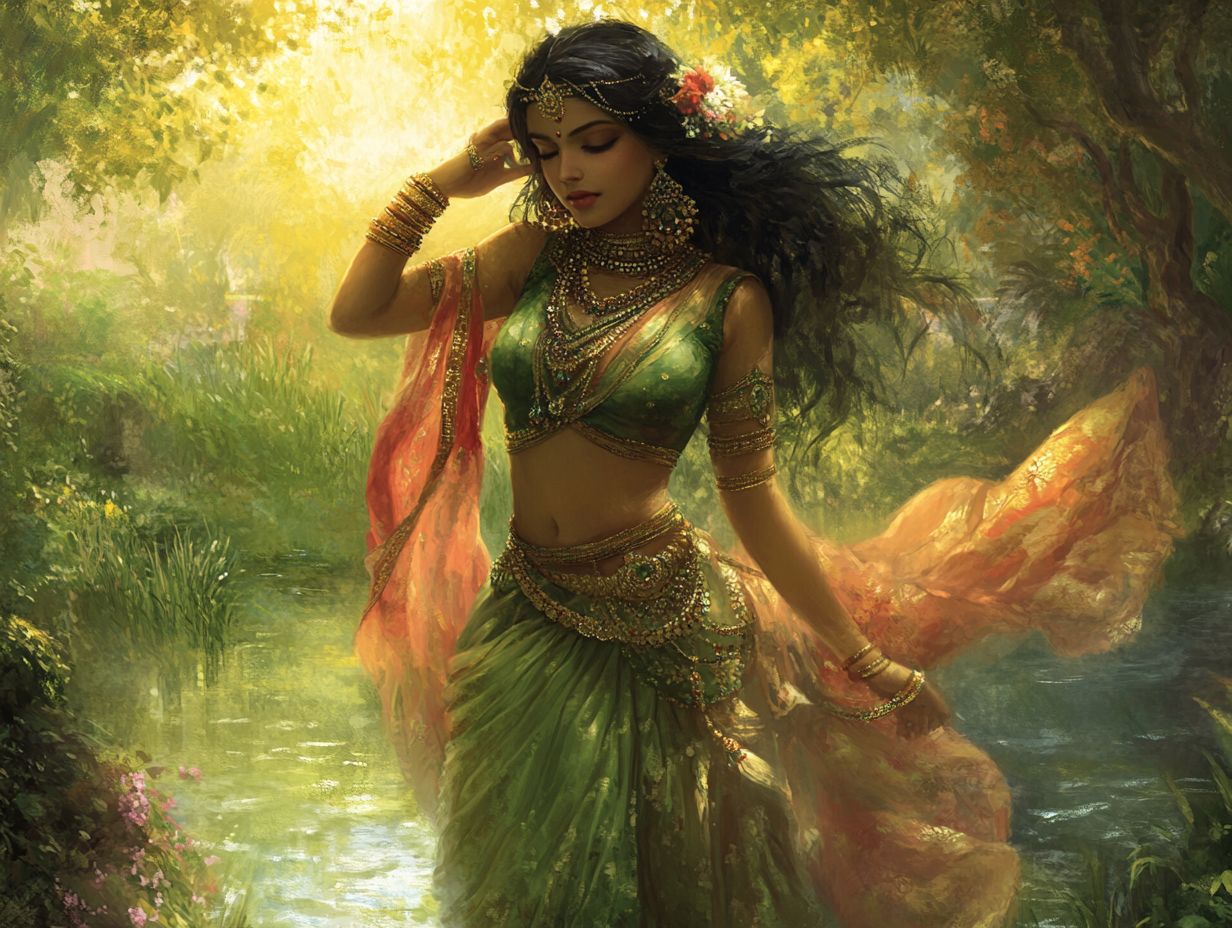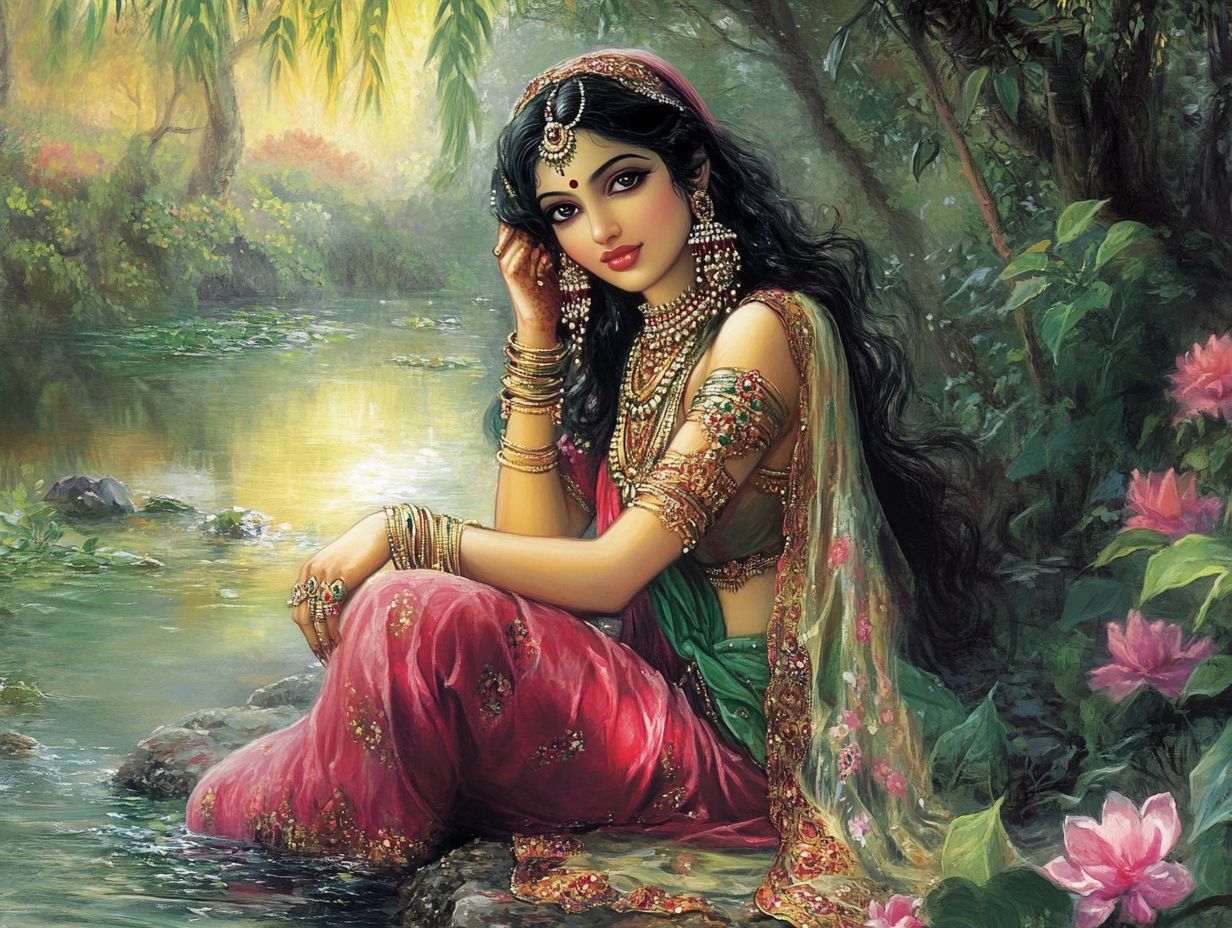Who is Mohini in Hinduism?
Mohini, a captivating figure in Hindu mythology, embodies the intricate duality of beauty and power. Renowned for her enchanting charm, she occupies a pivotal role in various legends, frequently linked to divine interventions and the timeless struggle between good and evil.
This exploration delves into the multifaceted persona of Mohini, examining her symbolic meanings, places of worship, rituals, and her enduring influence on contemporary Hindu culture. It thoughtfully addresses the controversies surrounding her representation, as well as the ongoing debates regarding her gender, inviting readers to uncover the complexities of this legendary figure.
The Legend of Mohini

The legend of Mohini, an enthralling goddess within Hinduism, encapsulates the essence of feminine energy, illusion, and transformation. She stands as a profound representation of the divine feminine and its intricate interplay with the cosmos.
Frequently portrayed as the mesmerizing avatar of Lord Vishnu, Mohini assumes a vital role in numerous Hindu mythological narratives, where her divine play restores cosmic balance and illustrates the complex duality of existence.
Through her enchanting presence, she accentuates themes of seduction and resilience, symbolizing the formidable power of feminine archetypes within the rich tapestry of Hindu beliefs and spirituality.
Who is Mohini in Hindu Mythology?
In Hindu mythology, Mohini is celebrated as an extraordinarily beautiful goddess and the singular female avatar of Lord Vishnu, personifying the divine feminine and the intricate layers of feminine energy.
Her origin can be traced back to the grand cosmic churning of the ocean, known as Samudra Manthan, marking a significant turning point in mythological tales. The emergence of Mohini captivated both the Devas and Asuras, serving as a potent symbol of seduction and transformation.
Beyond her unmatched beauty, she plays vital roles in various legends, most notably in the episode where she safeguards the nectar of immortality, ensuring its distribution solely to the righteous. This protective dimension underscores her importance within Hindu beliefs, where she is revered as a formidable guardian of dharma.
Mohini embodies the duality of feminine archetypes, merging nurturing and fierce qualities, thus reflecting the multifaceted nature of womanhood across diverse cultural narratives.
What are the Stories of Mohini in Hindu Scriptures?
The tales of Mohini are both rich and diverse, prominently showcased in various Hindu scriptures, including the Puranas and the Bhagavata Purana. She is revered as the enchanting deity who captivates the hearts of both gods and demons alike.
Her divine allure is particularly striking during the legendary churning of the ocean, known as Samudra Manthan, where she manifests her mesmerizing form to distribute the coveted nectar of immortality. Within this narrative, her interactions with celestial beings and their demonic counterparts illustrate the delicate balance of cosmic forces, revealing how seduction and charisma can alter allegiances and determine outcomes.
Mohini’s cunning not only guarantees that the gods receive the nectar but also serves as a poignant reminder of the duality inherent in creation, where beauty and power converge to sustain harmony in the universe.
Symbolism of Mohini in Hinduism
In Hinduism, Mohini epitomizes the intricate notions of illusion and enchantment, embodying the divine feminine’s extraordinary ability to transform and mesmerize with her beauty and allure. Her imagery serves as a striking reminder of the duality present in creation, where she encapsulates both nurturing and destructive forces, illustrating the complexities of feminine energy.
As an archetype, Mohini is portrayed in diverse forms of art and ritual practices, underscoring her importance within Hindu spirituality and cultural narratives. In these expressions, her seductive power becomes a crucial instrument for divine intervention and the maintenance of cosmic balance.
What Does Mohini Represent in Hinduism?
Mohini embodies the divine feminine within Hinduism, illustrating profound themes of illusion, transformation, and the intricate balance of power and seduction. As a goddess who personifies the dualities of creation and deception, Mohini captivates observers not only with her breathtaking beauty but also with her astute intellect and strategic acumen.
This multifaceted nature exemplifies the complexities of the feminine archetype, where nurturing qualities coexist harmoniously with an alluring sense of mystique. Mohini’s influence permeates various cultural practices, where she is revered not merely as an object of desire but as a formidable agent of change, often invoked during rituals aimed at restoring equilibrium.
Her role transcends mere representation; she stands as a symbol of give the power toment, challenging traditional norms and inspiring a deeper understanding of femininity within spiritual contexts.
What are the Symbolic Meanings of Mohini’s Appearance?

The appearance of Mohini is steeped in rich symbolism, defined by her ethereal beauty and graceful demeanor that capture the essence of the divine feminine and the power of cosmic balance.
Her attire is crafted with meticulous attention to detail, often portrayed in vibrant, flowing garments that seem to dance with the wind, epitomizing the fluidity and adaptability inherent in femininity. The colors she dons radiant reds, serene blues, and lush greens each convey a spectrum of emotions and energies, reflecting her multifaceted nature.
Adorned with intricate jewelry that glistens in the light, these embellishments not only enhance her beauty but also signify strength and protection. Every facet of her appearance is a testament to give the power toment, inviting admiration while simultaneously challenging societal norms.
Through these visual representations, she embodies the harmonious interplay between sensuality and strength, serving as a compelling reminder of the creative forces that reside within the universe.
Worship of Mohini in Hinduism
The worship of Mohini in Hinduism is marked by vibrant rituals and festivals that honor her divine qualities and the transformative power she represents within the spiritual practices of her devotees.
These celebrations not only reflect the deep reverence for this enchanting goddess but also embody the profound impact her essence has on the spiritual journeys of her followers.
Where is Mohini Worshipped in Hinduism?
Mohini is revered in numerous locations throughout India, particularly in temples specifically dedicated to her, often alongside Lord Vishnu. In these sacred spaces, devotees partake in a variety of rituals that honor her divine essence.
Among the notable sites are the renowned Vishnu temples in South India, particularly those in Tamil Nadu, where grand festivals unfold, showcasing traditional dances and offerings that pay tribute to her captivating beauty and formidable prowess. Within these hallowed grounds, rituals frequently encompass the chanting of mantras, the art of alankaram, and the presentation of fresh flowers, all believed to attract her divine blessings.
The cultural significance of these practices underscores the delicate balance of divine energies, illuminating Mohini’s crucial role in the maintenance of cosmic order. Such customs not only connect devotees to their spiritual heritage but also enrich the intricate tapestry of Hindu worship, nurturing a profound bond with the divine through vibrant communal participation.
What are the Rituals and Festivals Associated with Mohini?
Rituals and festivals associated with Mohini vividly illustrate the expressions of devotion and celebration among her followers, underscoring her profound significance in Hindu culture and spirituality.
These festivities are often characterized by vibrant processions adorned with floral decorations and intricate sculptures that beautifully capture Mohini’s enchanting essence. Dance takes center stage, as traditional forms such as Kathak and Odissi are performed to narrate her timeless tales, mesmerizing audiences with their elegance and rhythm.
The performances are enriched by music that intertwines sacred chants with melodious tunes, fostering an atmosphere filled with joy and reverence. Elaborate rituals, including the lighting of lamps and the offering of sweets, deepen the cultural and spiritual connection to Mohini.
Through communal participation and shared devotion, devotees are invited to experience the essence of the divine feminine, celebrating the rich tapestry of their heritage.
Mohini’s Role in Hinduism
Mohini occupies a central position in Hinduism, embodying the essence of the divine feminine. Her presence profoundly influences a myriad of cultural practices, spiritual beliefs, and societal norms, weaving her influence throughout the tapestry of Hindu tradition.
Influence of Mohini in Hindu Culture and Society

The influence of Mohini resonates profoundly within Hindu culture and society, where her tales serve as vessels for moral lessons and ethical teachings. These narratives, found in sacred texts like the Puranas, highlight compassion and the transformative power attributed to the divine feminine.
Through her mesmerizing persona, Mohini embodies ideals of protection and liberation, frequently intervening to rescue the oppressed or restore harmony amid chaos, reflecting the cosmic balance in Hinduism. A striking example is found in the myth of the churning of the ocean (samudra manthan), where Mohini deftly outwits the demons (asuras) to ensure that the nectar of immortality remains safeguarded for the gods (devas), symbolizing the triumph of good over evil.
This act not only underscores the significance of wisdom and strategy in the face of malevolence but also elevates her status as a guardian of dharma, guiding her followers toward the embrace of justice and empathy in their everyday lives, embodying the principles of karma and cosmic order. Her stories provoke profound introspection, encouraging individuals to tap into their inner strength, thereby shaping societal norms surrounding gender and virtue within the expansive tapestry of Hindu mythology, as recounted in the Vedas, Upanishads, Ramayana, and Mahabharata.
Mohini’s Role in Hinduism Today
Mohini’s influence can be observed in various forms such as art, literature, dance forms, and celebrations.
In modern Hinduism, Mohini’s role remains a vibrant aspect of spirituality, celebrated through rituals, cultural practices, and teachings that align with contemporary beliefs surrounding feminine energy and divine intervention. Her presence is honored in festivals and rituals highlighting her spiritual significance.
Her figure transcends mere symbolism, embodying both beauty and enchantment, while also serving as a powerful representation of the divine feminine. Mohini exemplifies the intricate balance between creation and destruction, symbolizing the dual aspects of the divine feminine.
Numerous spiritual movements today draw inspiration from her narratives, adapting her teachings to guide individual spiritual journeys and cultivate a deeper connection to inner strength, illustrating her role in spiritual awakening. In various contemporary practices, devotees often invoke her qualities during meditation or incorporate her stories into workshops designed to give power to women, recognizing her as a sacred archetype of the divine feminine and spiritual guide. This demonstrates how her archetype continues to resonate, shaping personal experiences of the sacred and highlighting the transformative nature of spirit in everyday life, contributing to a deeper understanding of spirituality and mysticism.
Controversies Surrounding Mohini in Hinduism
The controversies surrounding Mohini in Hinduism stem from her intricate depiction as a goddess and avatar of Vishnu, which ignites discussions regarding her gender, the essence of her enchantment, and the broader implications of her representation within the dualistic framework of divine narratives.
Criticism of Mohini’s Representation in Hinduism
Criticism surrounding Mohini’s representation in Hinduism frequently focuses on her depiction as an enchantress, igniting discussions about the implications of interpreting feminine power through the lens of seduction and illusion.
Some feminist scholars contend that this characterization perpetuates detrimental stereotypes, reducing women’s identities to mere objects of desire or trickery, rather than highlighting their agency and complexity, thus challenging traditional power dynamics and gender roles. By framing Mohini primarily as a figure of allure, the narrative risks reinforcing traditional gender roles that value women’s worth based on their attractiveness and ability to manipulate male desire, overshadowing her spiritual significance and divine motherhood aspects.
In contrast, others propose that Mohini’s multifaceted role offers a unique opportunity to challenge these norms, presenting an alternative perspective where femininity is intertwined with cunning intelligence and strength, reflecting her duality and spiritual significance. This duality encourages a deeper exploration of how divine femininity is constructed and perceived within the intricate tapestry of Hindu mythology, and its representation in sacred texts and religious practices.
Debates on the Gender of Mohini in Hinduism
Debates surrounding the gender of Mohini illuminate the intricacies of her character, prompting inquiries into whether she embodies a strictly feminine essence or if her role transcends conventional gender binaries within Hinduism, showcasing the fluidity of gender in sacred narratives.
This exploration leads to a profound appreciation of her dual identity, revealing that she serves not merely as a goddess but also as an avatar of Vishnu, wielding her alluring power in ways that challenge traditional notions of femininity. Some perceive her as a formidable figure who skillfully manipulates gender norms to fulfill divine purposes, while others contend that she reinforces stereotypes of femininity, presenting a complex duality that mirrors the nuanced perspectives inherent in Hindu beliefs.
These discussions are essential, as they reflect broader cultural dialogues about gender roles, urging society to reevaluate entrenched notions of masculinity and femininity, and consider the broader metaphysical implications. By scrutinizing Mohini’s role, one can uncover how such figures often epitomize the fluidity of gender within the spiritual realm, inviting interpretations that resonate with contemporary issues of identity, duality, and cultural relevance.
Frequently Asked Questions

Who is Mohini in Hinduism?
Mohini is a female avatar of the Hindu god Vishnu, celebrated in various festivals and rituals.
Mohini is a female avatar of the Hindu god Vishnu.
What is the significance of Mohini in Hindu mythology?
Mohini is known for her role in the story of the churning of the ocean of milk (samudra manthan), where she helps the gods defeat the demons and obtain the nectar of immortality, symbolizing the triumph of divine order.
Mohini is known for her role in the story of the churning of the ocean of milk, where she helps the gods defeat the demons and obtain the nectar of immortality.
Is Mohini considered a goddess in Hinduism?
While Mohini is not typically worshipped as a standalone deity, she is revered as a powerful and important aspect of Vishnu.
What is the story behind Mohini’s creation?
In Hindu mythology, Mohini was created by Vishnu in order to deceive and defeat the demons who were trying to obtain the nectar of immortality.
Are there any temples dedicated to Mohini?
There are a few temples in India dedicated to Mohini, including the Mohini Madan temple in Rajasthan and the Mohini temple in Odisha.
What does the name Mohini mean?
The name Mohini comes from the Sanskrit word “moh” meaning “to enchant” or “to delude,” reflecting her role as a seductive and deceptive figure in Hindu mythology, embodying the power of illusion and enchantment.
The name Mohini comes from the Sanskrit word “moh” meaning “to enchant” or “to delude reflecting her role as a seductive and deceptive figure in Hindu mythology.
